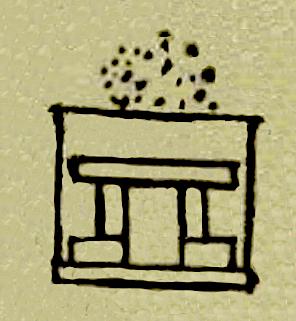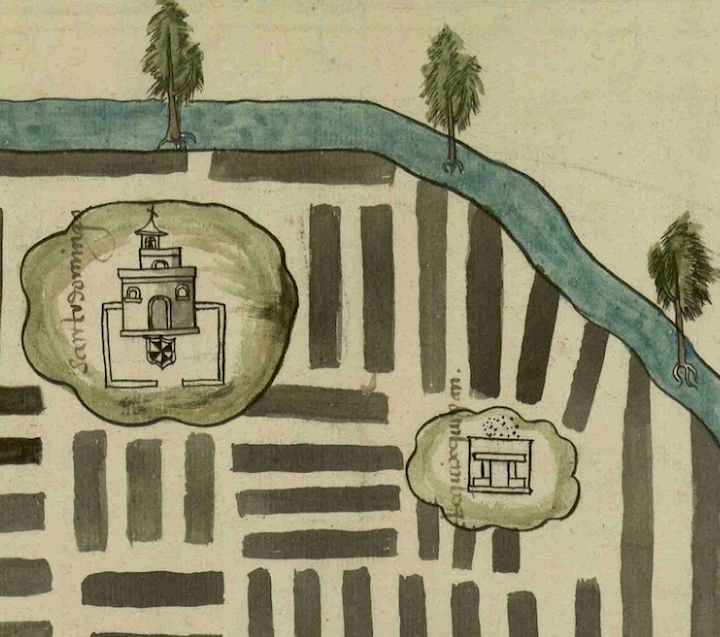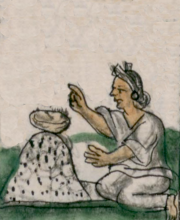Tequixquipan (T2681:6:2r)
This is a compound glyph naming the community of Tequixquipan in the Chalco region of the Valley of Mexico. It consists of two elements, one a logogram for tequixquitl), or saltpeter. The second element is a house (calli), a semantic indicator for the locative suffix -pan, which means on, at, etc. The saltpeter appears as a cloud-like set of dots above the building’s roofline. This echoes a depiction of saltpeter found in Book 10 of the Florentine Codex (see the museum and rare book comparisons, below), which is an outlined mound studded with black dots in a white field.
Robert Haskett
This compound glyph appears on a mapa submitted by Indigenous petitioners from the pueblo of Cuitlahuacan, Chalco, sometime before March 24, 1579, when a canoe-born investigation was carried out of a region of chinampas (artificially constructed raised fields represented by narrow rectangular dark brown bars in the shallow waters of a laguna) near the sujeto (dependency) of Santa María Magdalena Michcalco (also called an estançia). Tequixquipan was another sujeto in the area and appears on the same map (see the historical contextualizing image). According to the petitioners, a man named Bartolomé Arias was attempting to gain a property grant from the viceregal authorities that would compromise indigenous land tenure (an effort that ultimately failed). Contextually, the glyph for Tequixquipan is sited on a black-outlined oval figure—with a band of green shading inside running around the boundary—that might indicate an island (a similar element on the map lacks any other features, but is glossed as tierras as opposed to the chinampa elements, which are glossed in Spanish as camellones, or "ridges"). In fact, one of the Spanish records associated with the map contains the statement that a neighboring community called Michcalco is on something “like a kind of island” (folio 4r), a featured rendered in the same way as that of Tequixquipan. Whether this is a natural feature, a more substantial kind of chinamitl, or a combination of these things is not entirely clear This piece of land may be a second semantic indicator for an inhabited place (see the historical contextualizing image). An alphabetic gloss of the place name is written next to the left wall of the house. This was partly damaged when the thick, black outline for the island was added on top of it; a certain amount of reconstruction was necessary to make the gloss readable (see below).
Robert Haskett
tequixquipan
Tequixquipan
Robert Haskett
1579
Robert Haskett
saltpeter, salitre, minerals, minerales, casas, edificios
Tequixquinamacac, “one who heaps up saltpeter. He [sic] sells saltpeter [which is] white; with potshards….” (Anderson and Dibble, trans. and ed., Florentine Codex, Book 10, The People, Chapter 23, page 93). This image is from a digital version of the manuscript, Library of Congress, https://www.loc.gov/item/2021667856/, appearing on folio 69v. In Book 11 there is an entry for a plant called tequixquiçacatl that "grows in ashes, in ash pits" (pg. 193 of the Anderson and Dibble edition).

tequixquitl, saltpeter, https://nahuatl.wired-humanities.org/content/tequixquitl
-pan, a locative meaning on, at, over, on top of, with, https://nahuatl.wired-humanities.org/content/pan
En el Salitre
Robert Haskett
Single-page codex, Archivo General de la Nación, México, Ramo de Tierras Vol. 2681, Exp. 6, Fol. 2r.
The Archivo General de la Nación (AGN), México, holds the original manuscript. This image is published here under a Creative Commons license, asking that you cite the AGN and this Visual Lexicon of Aztec Hieroglyphs.




